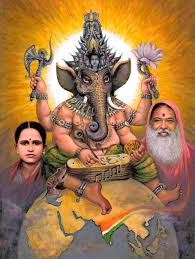Lord Brahma continued, “Go and seek forgiveness from Shiva. Due to your actions He has been separated from his beloved wife. Your insulting words have caused him deep anguish. If that Lord is angered it will spell destruction for the entire creation together with all its presiding deities.
Nāhaṁ na yajño na ca yūyam anye ye deha-bhājo munayaś ca tattvam
Viduḥ pramāṇaṁ bala-vīryayor vā yasyātma-tantrasya ka upāyaṁ vidhitset
Shiva is ever independent Lord. Not me, nor Vishnu nor any of the Maharishis can ever understand His real form! Nor can we estimate his real prowess! To be truthful none of the living entities can ever know the truth about Him! It is impossible. If such Shiva gets angry, who will take the responsibility to calm Him down? Who will dare approach Him?”
Thus Brahma instructed the Devatas. Thereafter He led the Devatas, Prajāpatis, forefathers (pitr-devatas) to Kailasa, in order to meet Shiva.
To Shiva, the destroyer of demons Tripurāsura, Kailasa, the most supreme among all mountains, is the favorite residence. Accomplished beings serve Mount Kailasa either through spiritual accomplishments, medicinal herbs, Yoga, mantra or penance. Celestials such as Gandarvas, Kinnaras and Apsaras live there permanently.
The peaks of Mount Kailasa are replete with varied kinds of precious gems and stones. These peaks illumine due to the presence of the many special minerals such as gold and hematite. They are surrounded by many medicinal herbs, creepers, trees and bushes. Various types of animals wander in groups enlivening the place.
In the many waterfalls that exist there, water is exceedingly pure. Accomplished beings along with their wives leisurely wander amidst these peaks which are replete with beautiful streams, waterfalls and caves. The grandeur of the peaks fills them with delight.
The entire mountain resounds with the sweet chirping of the peacocks. A swarm of bees, intoxicated due to consumption of nectar, fly all around the place buzzing melodiously. Cuckoos tunefully sing all the time. The peaks of this mountain always echo with the enchanting chirps of varied types of birds.
Seeing the tall trees resplendent with fruits and tender shoots that attract birds, it appears as if the mountain, with its raised hands, is inviting the birds to be its guests! Seeing the herds of elephants that joyously move around, it appears as if the mountain itself is moving! The sounds of the gushing waterfalls appear as if the mountain itself is talking!
Due to the presence of trees such as kalpavriksha, pārijāta, hibiscus, mango, kadamba, nāga, punnāga, champaka, aśoka, sandal wood, mehendi and many others, Kailasa Mountain illumines magnificently. With lotuses that have hundred golden-coloured petals, jasmine creepers, oleander plants, fine variety of jasmine, cardamom, uttareni tree and crab’s eye creepers, the entire mountain looks majestic.
The mountain is abundant in jackfruit, banyan, cluster fig tree, peepal, asafoetida, bhojpatra, betel-nut, julāra, jamun trees which add to the beauty of the place.
Banana and other similar plants which produce only a single crop are to be seen in plenty. In addition to date-palms, inguda, morati and other trees which decorate the place, Kailasa also looks imposing with plentiful bamboo crops”.
What is the necessity of mentioning in detail the names of the various types of trees? There is reference to the many flowering trees, fruit-yielding trees, creepers and climbers. The beautiful waterfalls and other water bodies are also mentioned. Here it talks about the melodious chirping of the birds, the buzzing of the bees that are intoxicated due to drinking nectar from flowers. Why are the many species of birds and animals mentioned in Bhagavatam? It is to drive home the fact that it is our duty to preserve nature. Each and every type of tree mentioned here is precious. Due to the presence of the bountiful varieties of trees, animals and birds, Nature becomes beautiful!
